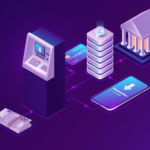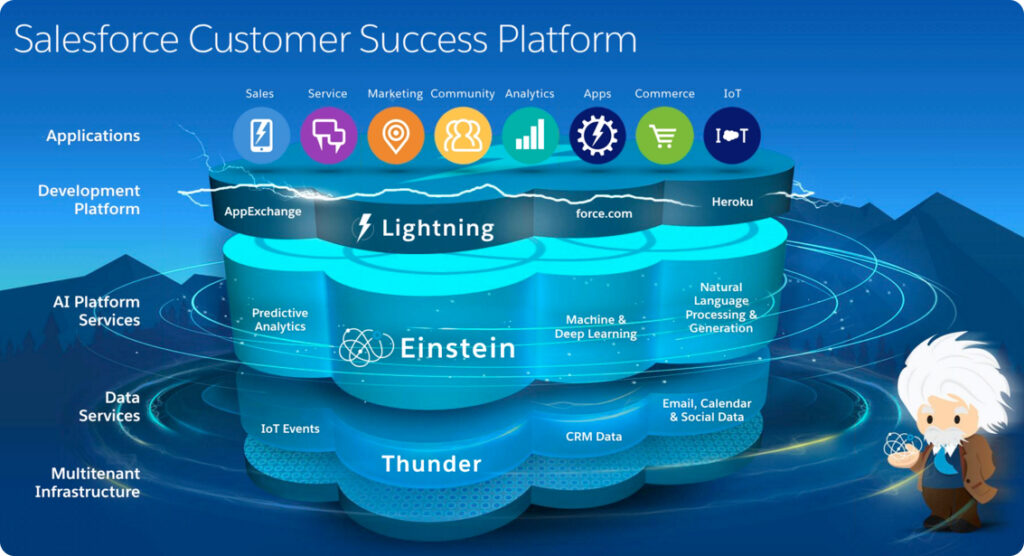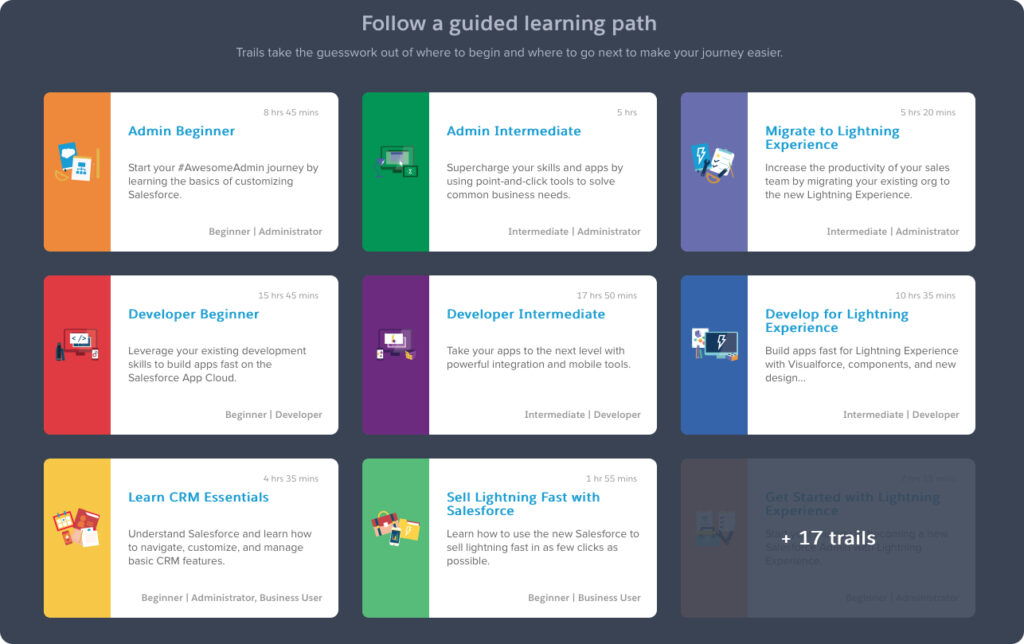Salesforce vs Microsoft: What is the Best Platform for Business App Development
Why are entrepreneurs and executives of large enterprises demanding more functionality, more scalability, more mobility today? Businesses can’t grow without nurturing customers, and consumer expectations have changed dramatically in recent times. People expect seamless customer support along with smooth purchase experience via their preferred means of communication – mobile phones. But beyond the direct connection with your clients, mobile applications are vastly extending software capabilities.
When searching for the development platform, entrepreneurs choose either the simplest one to deal with or the platform that gives access to the very best ecosystem. Salesforce & Microsoft are leading players in the platform-ecosystem world, offering serious assets for entrepreneurs and developers alike. Both are aiming to be a comprehensive solution to serve the growing business needs: from CRM technology offerings to robust cloud app development tools to AI-based products.
The two tech giants are archrivals with a long story of struggling for the business software market leadership. Microsoft dominated the enterprise app market for a long time, but Salesforce reshaped it with cloud offerings, changing the game for older software providers. The company built a billion-dollar empire from CRM following the main idea: deliver software round the clock to people over the cloud. It took Microsoft pretty much time and billions of investments to enter the SaaS market where Salesforce was a king. The fierce competition on various cloud fronts required constant improvements from all players.
So, let’s figure out which platform is a better choice not only from the technology perspective but as an environment to build a high-growth business.

Development tools and experience
The main Salesforce developer instrument is Force.com or Lightning Platform that accelerates app creation and makes it more efficient. The PaaS platform incorporates the tools – from low code to code – Heroku, SalesforceDX, App Builder, Lightning Flow – dramatically speeding up the building process while allowing for high-level customization and configuration.
Low code capabilities
Low code tools provide many benefits and open up an enormous opportunity to get non-technical employees involved in the application development process. At the same time, coders get the flexibility to customize complex data integrations, logic, UI via hand-programming.
Gartner recognized the importance of low-coding when it released a Magic Quadrant for Enterprise Low-Code Application Platforms in 2019. Salesforce tops the Leaders quadrant, showing persistent growth and innovation. Microsoft was in the Challengers quadrant in 2018 and jumped to the Leaders only in 2019.
With Lightning App Builder, the employees with no prior coding experience or development know-how can create responsive business applications that work on desktops & mobile phones. There is an entire library of pre-built components that can be easily assembled into an app, with the option of creating custom components, reuse them in other applications or publish on the AppExchange, Salesforce app marketplace. Your Lightning Apps auto-connect with all your data stored on the platform, simplifying the developer’s job.

Lightning Flow is another declarative tool that empowers users to create business process automation for apps through Process Builder & Flow Builder point-and-click functionality. Innovative technologies like AI-powered analytics tool Einstein can be seamlessly embedded into your software while IoT Explorer Edition allows you to build solutions on top of IoT data.
Microsoft’s alternative is the Power Platform, a low-code environment that allows non-technical users to build custom applications, user interfaces, business workflows. It isn’t a product on its own, but rather a group of products: PowerApps, Power Automate, and Power BI.

PowerApps is a low-code solution that brings the power of process automation to the business audience. It’s quite possible to construct mobile apps by adding different controls and screens via a drag-and-drop UI if you have at least some technical understanding. Power Automate serves for the creation of automated workflows between your software and third-party applications. Leveraging the Power BI tool for data analytics, you can draw data visualizations and connect external data sources.
Developer Experience
PowerApps’s biggest strength is its compatibility with a wide range of Microsoft products & Office applications. However, there are very few options to tweak code. The product is perfect for building some simple apps such as contact lists or mobile surveying applications. But it’s not the best choice if you demand heavy customization of a project.
Lightning’s “design once, use anywhere” approach for desktop and mobile interfaces accelerate business processes, allowing end-users to easily interact with applications. Point-and-click features can be used to not only just build business logic but also access developer-built code. Advanced users and programmers can customize workflows and integrate it with external sources using Apex language. Yet newcomers will require the training to build highly customized applications.
Solutions for complex custom business processes
For experienced coders, Salesforce offers a powerful but more technically challenging development tool Heroku, which supports popular programming languages: Ruby, Java, PHP, Node, etc. Heroku is a cloud service platform that takes care of hardware, operating systems, servers, allowing developers to concentrate on creating software rather than infrastructure. Focused on building consumer-facing apps, Heroku enables simple application development and deployment as well.
The PaaS provider recognizes the demands for traditional development methods to address the business requirements for more complex solutions. Catering to conventional developers, Salesforce launched a cutting-edge environment, which is committed to providing the needed support and tools. SalesforceDX boosts developer productivity with modern life-cycle management tools that enable true version control, improved team collaboration, and agile development. Combining features from Force.com and Heroku Flow, all functionality is pulled into one place additionally enhanced with continuous integration capabilities. Note, that DX primarily targets the conventional developers with strong coding skills and knowledge of open programming languages like Node or Java.
SalesforceDX features & tools
- Salesforce Command-Line Interface (CLI) helps in retrieving metadata, creating a project, exporting & importing data, and manipulating scratch orgs. This tool makes it much easier and more pleasant to develop custom solutions.
- Scratch orgs are lightweight environments for development and testing that you can launch on-demand. They are essentially mini developer orgs that allow working upon a different piece of work independently. This is the killer feature in enabling more traditional dev workflow and version control as a source of truth. You can use these orgs as a temporary environment to make changes and destroy them with a single script when done. It helps build your app consistently over and over again, which is great for team collaboration and test automation.
- Version Control System (VCS) is a mechanism for keeping track of your code. VCS serves as a backup in case you need to roll back to previous versions of your software and supports collaboration with your team.
- Continuous Integration (CI)-enabling features: automated deployments off of GitHub repositories allows keeping track of any changes in your code and traceback code snippets to a specific point of time. Integration with Heroku Flow that supports orgs as a target environment means you can build out a deployment pipeline that can make changes from your VCS and promote them between environments.
Installing Visual Studio Code, a lightweight open-source editor for engineering and debugging cloud applications is necessary if you want to leverage features like SalesforceDX. VS Code with the Salesforce supported extensions like Apex, Visualforce, Aura Components, Apex Interactive Debugger, Apex Replay Debugger make interacting with SFDX commands hassle-free.
All these tools and features along with Heroku pipelines and CI play a crucial role in making the developer tasks easier, deployment faster, project management painless.
Microsoft Azure: Tools & Services
Azure is a cloud computing service that provides resources a business needs to run all or part of operations virtually, including storage, networking, analytics, engineering, deploying, and managing cloud-designed apps. You have the option of scaling resources according to business requirements.

Visual Studio is the full-featured tool for coding, which is used primarily for .NET & C# languages and is only available on Windows. Don’t confuse it with the VS Code, which is an open-source editor. Beyond these integrated development environments, you can use a range of language-specific SDKs for creating software in a programming language of your choice.
Developers can leverage different Azure Services based on their needs, project scale, etc. So let’s take a look at the core services intended to facilitate cloud-native app development.
Azure DevOps
This hosted service helps development teams improve project management, modernize release processes, optimize operational activities when creating and deploying software either in the cloud or on-premise. Azure provides an all-in-one DevOps toolchain to ensure efficient, secure, and collaborative work on the projects while removing technical and bureaucratic hurdles. Some key tools available include:
- Git repositories for source control
- Language and cloud-neutral CI/CD automation platform
- Agile tools covering Kanban/Scrum project methodologies
- Custom dashboards for planning, tracking, reporting
- Test plans support advanced test management solutions for customer feedback and automation testing
Azure App Service
This PaaS solution from Microsoft intends to be the dedicated one-stop-shop for cloud-based software engineering. App Service is a big family of services for developing web apps, mobile backends, and RESTful APIs. This allows a developer to focus on creating applications, not on running it. The platform is a set of services, each bringing something unique to the table. It includes:
- Web Apps tool assists with building and running web & API applications in Azure without having to deploy, configure, or maintain them
- Mobile Apps help create backend logic in C# or Node and implement mobile features like data storing or sending push notifications. This service allows building cross-platform & native apps that run on Windows, Android, or IOS.
- API Apps for simple logic workflows creation due to the pre-built connectors
- Logic Apps introduces a serverless architecture for various services to be integrated into an app without writing codes but via connections to SaaS software and on-premise data
Azure Data Services
Azure covers a wide range of data-related needs for cloud-designed apps when near-zero administration and enterprise-grade capabilities are key. Developers can utilize either SQL or NoSQL data services for file storage, text searching, time-series data based on the application demand. Cosmos DB is a top Azure cloud computing offering for globally scalable projects. This multi-model database enables you to elastically scale throughput and storage, and enjoy fast data access using popular APIs.
This isn’t a full list of services that businesses can employ. Azure proposes an array of computing, databases, analytics services for building powerful enterprise solutions.
Click over code vs .NET programming customization
In the .NET environment, you can create custom layouts, design your theme, and handle all the user experience via hand programming. Also, you need to have a sound code knowledge to design interfaces that scale across multiple devices on .NET.
On the other hand, Salesforce’s overriding proposition is that it provides tons of capabilities out of the box, enabling endless customization without coding. First configure, then customize using declarative tools and extensions as per requirements. Its Lightning Design System allows creating layouts and user interfaces rapidly by dragging and dropping ready-to-use components. Applications built with Lightning automatically scale for mobile & desktop screen sizes. Tools for data analytics and reporting can be either created and embedded without code. This approach requires less developer force because non-technical users and admins can cope with this.
Training support
Another Salesforce’s significant asset is the educational network Trailhead. A gamified, free learning platform allows users to acquire the skills needed to be anything from an advanced user to an Administrator or a Developer. Whether you are a beginner or advanced, there are thousands of paths everyone can find the one to benefit from. Trailhead appeals to developers and business users like no other platform. There are even modules and trails guiding .NET developers to pick up Apex language. Beyond the educational content, you can put the acquired skills to the practice on Trailhead Playground for hands-on experience. Starting as a novice you can grow to a qualified developer.
Microsoft Learn is a direct response to Trailhead. The online educational center takes the principles and elements of gamification that are being used by Salesforce. The platform features guided and interactive courses where you earn badges for completing specific tasks. There are lots of Learning modules you can take, including Dynamics, Azure, Power BI, and more. The possibility to integrate content from LinkedIn Learning is the major strength of the platform.
The education and support of developers are critically important for a healthy developer ecosystem. While Microsoft has big ambitions for training support, Salesforce has been successfully growing certified admins and devs for years.
Ecosystems
Salesforce discovered that their consumers didn’t need software, but the solutions tailored to their specific needs. When custom software development was a costly way of growing business, the vendor built the business model on the partnership to address this issue. The cloud software provider cooperates with hundreds of independent software vendors, integrators, and consultants who support the technology and drive innovation for all of the users.
Salesforce operates the largest enterprise app marketplace, AppExchange. By opening up the platform to third-party vendors, the number of software complete solutions, applications, add-ons rose sharply. Currently, it offers over 5,000 apps paid and free of charge for clients to extend the functionality. The company applies rigorous approval processes, so be sure the apps are security-tested and peer-reviewed. Additionally, there is a large section of certified consulting partners who can help you with the development and listing of your own application on the leading marketplace.
Finally, the Trailblazer Community provides an environment for customers and partners to get answers and feedback on a product and share ideas. Altogether, Salesforce supports a growing ecosystem of technology partners, consultants, and customers that solve vital business problems.
Microsoft has spent a lot of time catching up with Salesforce. Microsoft AppSource ecosystem of third-party applications bears a sticking resemblance to AppExchange.
The marketplace offers the majority of apps as a try-before-purchase through a free trial option, so the user can find out if the app provides the capabilities they are looking for. AppSource provides two types of SaaS apps:
- Add-ons & extensions to the existing products; it can be a simple single-purpose feature, such as a mapping tool in an Office product or extensions such as a full module with a set of functionality for shipping management, for instance.
- Solution Apps are developed by ISVs to cover broader industry solutions. The listed applications offer a free trial and integration with Azure, Power BI, and other products.

Launched four years ago, AppSource lists approximately 6,000 apps and is evolving fast. Yet in Microsoft’s eagerness to turn it into something big quickly, they lowered the bar to entry for third-party developers, and it promptly filled up with low-quality software. From apps that will not even install to some that are downright security risks.
Gartner offers the serious cautions in its Magic Quadrant for Cloud Infrastructure as a Service 2019 regarding some of the platform imperfections.
The caution warns about the challenges with on-time implementations within the budget faced by Gartner customers, indicating that Microsoft sets unreasonably high expectations. Also, consumers complain about poor-quality technical support and field solution architects.
These implications are concerning even companies that predominantly use Microsoft.
Key takeaways
Microsoft is a new player to SaaS and PaaS markets, but we should admit that it evolves by leaps and bounds in this direction. Facing the market leader, the company chose to pursue the way that has proved to be successful. PowerApps, Microsoft Learn, and AppSource are still in the early days and lack the functionality and capabilities of Salesforce mature products. Their great advantage is in seamless integration with all the Microsoft tools and services. Known to many programs like Excel, SharePoint, Skype, Word, Outlook are now linked together and easily accessed via any of Microsoft cloud products. Although Salesforce does integrate with the same Office apps, it cannot touch the seamlessness of Microsoft integration. However, this is a drop in the ocean compared to what Salesforce offers.
Partner relationships, self-service training, advanced development tools, and enterprise value form a robust ecosystem for entrepreneurs, startups, and organizations that want to evolve quickly and strategically. Salesforce technology and services are centered around customer needs. Following their Clicks over Code concept, the vendor created an easy to use platform focused on the latest technologies that cover the needs of both business users and professional coders. Leveraging the tremendous opportunities of platform-ecosystem, you can build not just an enterprise application but a high-growth business.
Whether you need technical advice or a certified consultation on your product roadmap, you can always get in touch with Salesforce partners like Technology Grounds. We understand the business challenges you face and can help you build a solution that combines the best of strategy and technology.











